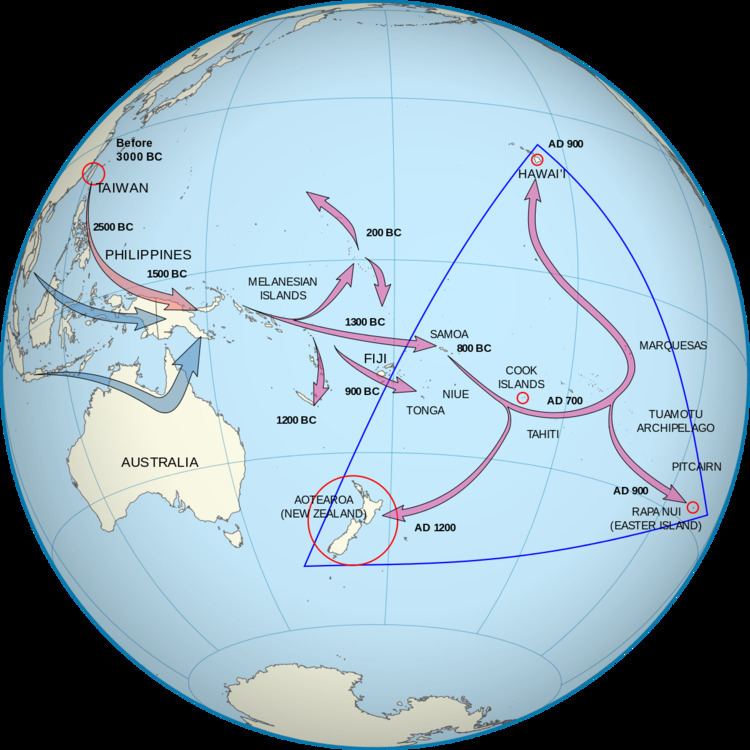United States 816,144 Australia 210,843 | New Zealand 598,605+ Chile 5,682 | |
 | ||
The Polynesian people consist of various ethnic Austronesian groups that speak Polynesian languages, a branch of the Oceanic languages, and inhabit Polynesia. The native Polynesian people of New Zealand and Hawaii are minorities in their homelands.
Contents
Origins
Polynesians, including Samoans, Tongans, Niueans, Cook Islands Māori, Tahitian Mā'ohi, Hawaiian Māoli, Marquesans and New Zealand Māori, are a subset of the Austronesian peoples. They share the same origins as the indigenous peoples of maritime Southeast Asia, Madagascar, and Taiwan. This is supported by genetic, linguistic, and archaeological evidence.
The origins of the Polynesian people are addressed in the theories regarding migration into the Pacific that began about 3000 years ago. These are outlined well by Kayser et al. (2000). The most widely accepted theory is that modern Austronesians originated from migrations out of Taiwan between 3000 and 1000 BC; travelling via the Philippines and eastern Indonesia and from the northwest ("Bird's Head") of New Guinea, on to Island Melanesia by roughly 1400 BC, reaching the western Polynesian islands right about 900 BC.. However, Soares et al. (2008) have argued for an older pre-Holocene Sundaland origin within Island Southeast Asia (ISEA) based on mitochondrial DNA.
Paternal Y chromosome analysis by Kayser et al. (2000) also showed that Polynesians have significant Melanesian genetic admixture. However, a follow-up study by Kayser et al. (2008) discovered that only 21% of the Polynesian autosomal gene pool is of Melanesian origin, with the rest (79%) being of East Asian origin. Another study by Friedlaender et al. (2008) also confirmed that Polynesians are closer genetically to Micronesians, Taiwanese Aborigines, and East Asians, than to Melanesians. The study concluded that Polynesians moved through Melanesia fairly rapidly, allowing only limited admixture between Austronesians and Melanesians. Thus the high frequencies of mtDNA B4a1a1 in the Polynesians are the result of drift and represent the descendants of a few East Asian females who mixed with Papuan males. The Polynesian population experienced a population bottleneck and genetic drift.
Recent DNA studies show that the Atayal people from Taiwan and the Kankanaey people of the northern Philippines, who later mixed with Melanesians, were most probably among the original ancestors of modern Polynesians.
The results of research at the Teouma Lapita site (Efate Island, Vanuatu) and the Talasiu Lapita site (near Nuku'alofa, Tonga) published in 2016 supports the 'out of Taiwan' theory although with the qualification that the migration bypassed New Guinea and Island Melanesia. The conclusion from the research published in 2016 is that the initial population of those two sites appears to come directly from Taiwan or the northern Philippines and did not mix with the ‘AustraloPapuans’ of New Guinea and the Solomon Islands. DNA analysis of modern Polynesians indicates that there has been intermarriage that results in a mixed Asian-Papuan ancestry of the Polynesians. The research at the Teouma and Talasiu Lapita sites implies that the migration and intermarriage, which resulted in the mixed Asian-Papuan ancestry of the Polynesians, occurred after the first initial migration to Vanuatu and Tonga. The preliminary analysis of skulls found at the Teouma and Talasiu Lapita sites is that the skulls lacks Australian or Papuan affinities and instead has affinities to mainland Asian populations.
People
There is an estimated 2 million ethnic Polynesians and their descendants worldwide, majority of which live in Polynesia, United States, Australia and New Zealand. The Polynesian peoples are shown below in their distinctive ethnic and cultural groupings (estimates of the larger groups are shown):
Eastern Polynesia
Western Polynesia
Polynesian outliers
